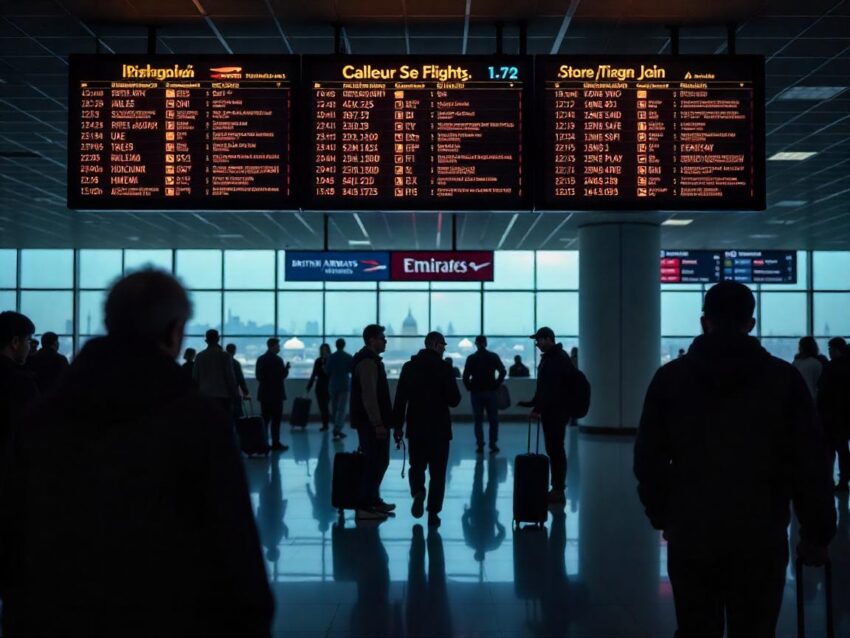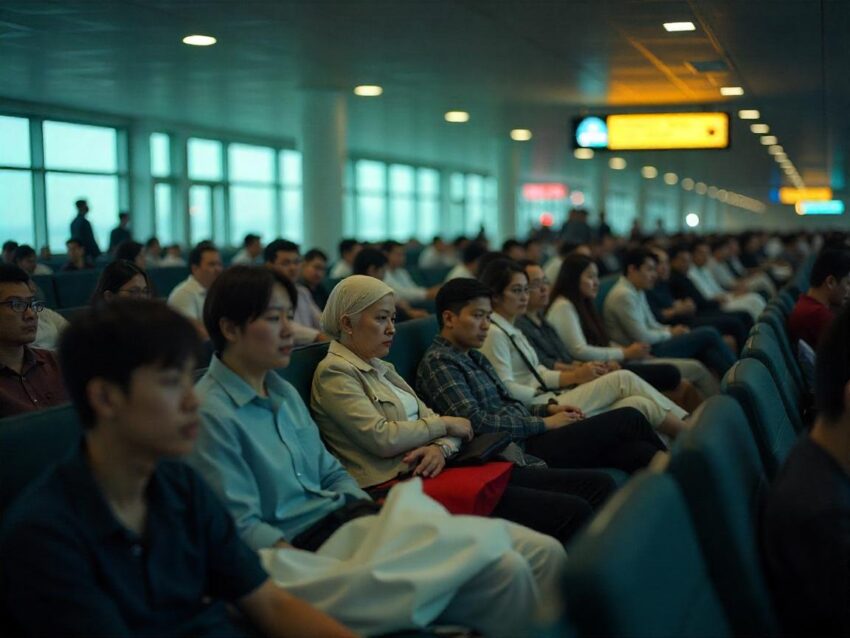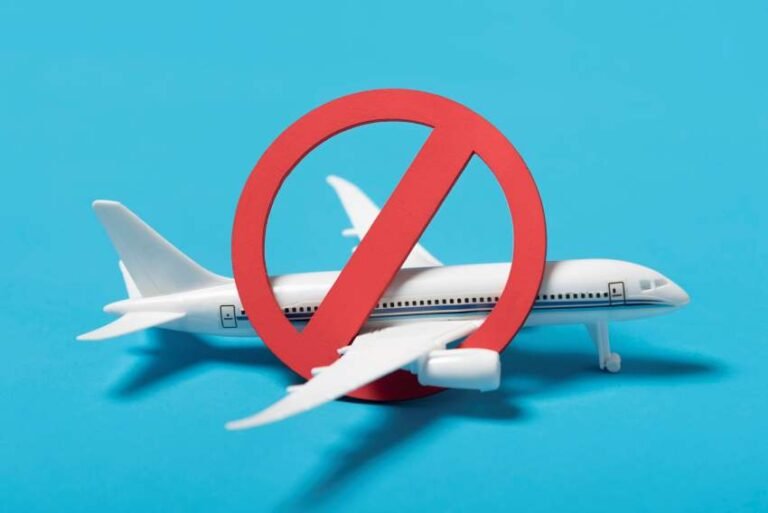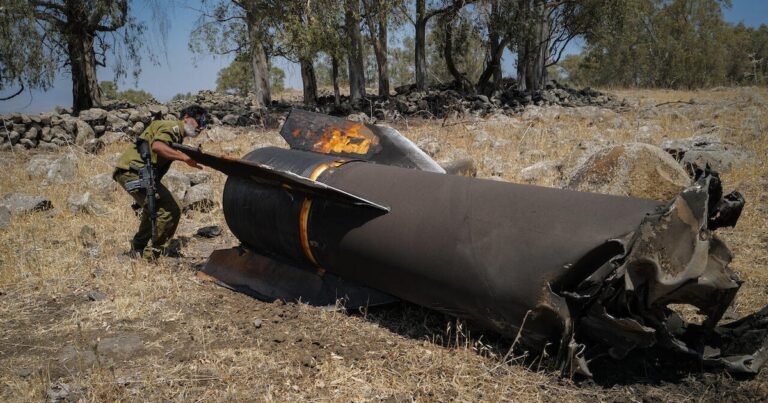
Tuesday, June 24, 2025

Major carriers including British Airways, Singapore Airlines, Emirates, and Qatar are now urgently slashing their Middle East flights as the Israel-Iran conflict escalates with alarming speed. What began as isolated tensions has spiraled into a full-blown regional crisis, sending shockwaves through global aviation. Routes to key Gulf destinations are vanishing overnight. Delays are growing. Options are shrinking. Meanwhile, travel updates are changing by the hour, leaving passengers in suspense and full details are here. This is not just another reroute—it’s a critical moment in air travel. A fast-moving storm is unfolding in the skies. Here’s the news travel update you need right now.
British Airways, Singapore Airlines, Finnair, Emirates, Qatar Airways, and Air France-KLM are now facing a new wave of disruption. These major global carriers are rapidly cancelling and cutting flights to and from the UAE, Saudi Arabia, Bahrain, and several other Middle East destinations. The reason? The escalating Israel-Iran conflict, which has taken a dangerous new turn following targeted strikes and retaliatory missile launches.
In what is shaping up to be one of the most unpredictable aviation crises of the year, airlines are being forced to react in real time. Major air Routes once considered routine are now under threat. Sky corridors are shrinking. And passenger safety has suddenly become more than a checklist—it’s now the central mission.
British Airways and Singapore Airlines were among the first to respond. Finnair joined the wave. Qatar Airways, based at the heart of the region, is making tactical adjustments. Even Emirates, a giant of Gulf aviation, has begun rerouting to avoid escalating danger zones.
Meanwhile, Air France-KLM has followed suit, suspending flights and watching the skies closely. The Middle East, once a global aviation bridge, is becoming a complex and volatile airspace.
As this conflict intensifies, the fate of thousands of passengers hangs in the balance. Flight plans are changing by the hour. The stakes are climbing fast. What once seemed like a regional skirmish is now disrupting global air travel networks.
This is not just about delays—it’s about safety, strategy, and survival in the sky. The full update you need is just ahead.
| Airline | Region Affected | Status / Suspension Period | Full Details |
|---|---|---|---|
| British Airways | Dubai, Doha, Tel Aviv | Canceled weekend; Doha/Dubai resumed Monday | Flights to Bahrain, Amman paused to June 30 |
| Air France‑KLM | Dubai, Riyadh, Tel Aviv, Beirut | Suspended through July 14 (TLV), June 25 (BEY), June 24 (RUH) | Includes Air France, KLM components |
| Finnair | Doha | Canceled to June 30/July 1 | Avoiding Iran, Iraq, Syria, Israel |
| Lufthansa Group | Tel Aviv, Tehran, Beirut, Amman, Erbil | Through July 31 (TLV/Tehran), June 30 (BEY), July 11 (AMM/EBL) | Avoiding all relevant airspace |
| Singapore Airlines | Dubai | Canceled to June 25 | Earlier canceled Sunday service |
| Emirates | Tehran, Baghdad, Basra, Iran, Iraq | Suspended to June 30 | UAE domestic unaffected |
| Qatar Airways | Iraq, Iran, Syria, Doha | Doha space closed; flights canceled | Qatar airspace closed |
| Turkish Airlines | Baghdad, Damascus, Tehran | Canceled until July 1 | Pegasus canceled Iraq/Jordan/Lebanon to June 30; Iran until July 30 |
| Flydubai and Etihad | Iran, Iraq, Israel, Syria, Tel Aviv | Flydubai to June 30; Etihad Tel Aviv to July 15 | Regional carrier adjustments |
| United / American / Air Canada | Dubai, Doha, Qatar | Suspended routes; no‑fee rebooks offered | Flight shifts in place |
| Air India / IndiGo | Iran, Iraq, Israel airspace | Rerouting/canceling flights | Air India cutting 15% intl flights including ME region |
War in the Skies: Airline Routes Disrupted as Middle East Conflict Escalates
The global air travel network is under fresh pressure as airlines scramble to reroute flights around escalating conflict zones in the Middle East. In just 48 hours since the US launched airstrikes on Iran, carriers have been forced to redraw flight paths, avoid entire countries, and absorb steep operational costs—all during the height of summer travel demand.
As missile strikes and military responses unfold across the region, airspace over Iran, Iraq, and parts of the Gulf has quickly become a no-go zone. Qatar’s sudden airspace closure and Israel’s restricted air operations underscore the volatile conditions now reshaping international flight corridors.
Update from Dubai International Airport
Due to recent airspace closures, flights from Dubai International (#DXB) and Al Maktoum International (#DWC) may face delays or cancellations. Passengers are advised to confirm their flight status with their airline before traveling to the airport to avoid inconvenience. Stay updated as the situation may change rapidly.
Global Flight Paths Now Caught in Conflict
Airlines from Europe to Asia are now forced into tight, fuel-draining detours. Flights that once cruised directly across the Middle East are being rerouted north over Georgia and Afghanistan or swung wide via Saudi Arabia and the Arabian Sea. The result? Longer journeys. Higher fuel burn. Increased crew costs.
These adjustments aren’t just inconveniences—they’re turning strategic routes into logistical nightmares. Key Gulf airports like Doha and Dubai, typically bustling international hubs, have seen rolling cancellations and restricted operations. British Airways, Singapore Airlines, Finnair, and Air France-KLM have all paused or diverted services to impacted cities.

Congestion Builds as Sky Corridors Shrink
Airlines were already navigating around Russian and Ukrainian airspace, closed off due to war. The new Middle East no-fly zones have squeezed global aviation into even narrower corridors.
This congestion is triggering air traffic delays, stretched crew schedules, and overstressed control systems. European operators have raised concerns over growing air traffic bottlenecks, warning that every added minute in the air equals lost time, lost money, and lower service reliability.
If more regional airspace becomes restricted, the ripple effect could choke air capacity across continents. Every diverted flight adds strain to an already strained network.
| Airline | Flights/Routes Affected | Status | Estimated Resumption |
|---|---|---|---|
| Etihad Airways | Tel Aviv | Suspended | Until July 15 |
| Flydubai | Baghdad, Basra, Tehran | Canceled | Through June 30 |
| EgyptAir | Tel Aviv, Beirut | Operating reduced schedule | Under continuous review |
| Royal Jordanian | Tel Aviv, Beirut, Damascus | Limited service | Day-to-day decisions |
| El Al Israel Airlines | Most international routes except for rescue missions | Operating rescue & repatriation flights | Only select departures active |
| Saudia (Saudi Arabian Airlines) | Israel, Iraq, Tehran | Monitoring with possible reductions | Suspended overflights in some zones |
| Oman Air | Iraq, Syria, Iran routes | Rerouting flights | Avoiding conflict airspace |
| MEA (Middle East Airlines – Lebanon) | Domestic and outbound Beirut routes | Heavily affected, rerouted or delayed | Major reductions expected |
| Kuwait Airways | Iraq, Iran, Syria | Rerouting or suspending select routes | Through end of June |
Passenger Experience Takes a Hit
For travelers, the chaos is beginning to show. Longer flight times are becoming routine. Delays are stacking up. Rescheduled routes are creating confusion, missed connections, and logistical headaches.
Worse, airline pricing is poised to climb. Jet fuel prices, already rising due to global instability, are now surging even faster. These increased costs, paired with rerouting inefficiencies, will ultimately fall on passengers.
Carriers that hedge fuel prices may delay fare hikes temporarily. But others—like budget giants Ryanair—are already signaling fare increases. Travelers planning international summer getaways may soon pay significantly more for the same routes.
Airline Stocks and Stability in Decline
Investor confidence in aviation is faltering. Since the initial Israeli strikes on June 12, airline stocks have dipped across the board. The financial blow is twofold: rising costs and reduced efficiency.
As aircraft detour around conflict, operations become slower and more expensive. For global carriers, profit margins are already thin. These disruptions threaten to erode them further—especially for those relying on intercontinental routes to fuel summer revenue.
Meanwhile, fleet deployment strategies are shifting in real-time. Some airlines are pausing long-haul operations entirely, opting instead to reallocate aircraft to unaffected short-haul markets. But these are short-term fixes to what could become a long-term geopolitical storm.
Aviation Safety Comes Under New Scrutiny
The deadly Air India crash earlier this month was already a sobering moment for aviation safety. Now, with missile ranges expanding and drone technology rapidly evolving, the threat to commercial airliners is becoming more complex.
Airlines are under increasing pressure to prove their routes are safe—not just efficient. Regulatory bodies like EASA have already issued advisories against flying over parts of Syria, Jordan, Lebanon, and Egypt. The list of unsafe skies is growing fast, and carriers must adapt instantly to avoid risk.
Public confidence in air travel rests on safety first. Every headline involving reroutes or near-conflict events chips away at that trust—especially for anxious flyers and families booking summer vacations.
Gulf Carriers Caught in a Strategic Bind
Airlines based in the Gulf—such as Emirates and Qatar Airways—are facing unique challenges. They operate close to the conflict epicenter and depend heavily on maintaining open skies for their global hub-and-spoke models.
While most services continue as scheduled, direct routes to cities like Tehran and Baghdad have been suspended. For now, these carriers are demonstrating resilience. But continued escalation could isolate them, reducing their competitive edge and putting pressure on their global dominance.
What Happens Next?
Aviation is no stranger to disruption. But this moment feels different. The layered complexity of geopolitical conflict, economic instability, and airspace restrictions presents an unprecedented challenge.
Industry analysts warn that if tensions continue or spread, entire routes between Europe and Asia could become financially or operationally unsustainable. The result? Fewer flights. Less competition. Higher fares. More delays.
The tourism sector, especially in regions dependent on international arrivals, will feel the impact too. Destinations connected by long-haul links may see visitor numbers drop, further impacting local economies already recovering post-Covid.

A World Still Desperate to Fly
Despite all of this, demand for travel remains high. Post-pandemic wanderlust is strong. Travelers are still booking. But they’re now doing so in a climate where safety, certainty, and price are all under threat.
Airlines are racing to stay agile. They’re navigating complex decisions that weigh passenger experience against operational survival. For now, the skies remain open—but more fragile than ever.
And for passengers staring out airplane windows this summer, it’s clear: the world is flying again. But the skies we fly through are shifting every day.
Global Air Travel Disrupted as Israel-Iran Conflict Forces Airlines to Cancel Flights Across the Middle East
The growing conflict between Israel and Iran has pushed the global aviation industry into a defensive position, as airlines across Europe, North America, and Asia suspend or reduce flights to major Middle Eastern destinations.
Triggered by escalating missile exchanges and US military strikes on Iranian nuclear sites, the crisis has quickly closed airspace and destabilized key routes through the region. Flights to the United Arab Emirates, Saudi Arabia, Iraq, Iran, and Israel are being canceled or rerouted at scale, just as the peak summer travel season begins.
This isn’t just a temporary setback—it’s a major threat to regional connectivity and global passenger movement.
Major Airlines Respond Swiftly to Volatile Situation
Within hours of the latest escalation, global carriers began grounding flights. British Airways cancelled services to Dubai and Doha, while Air France suspended operations to the UAE and Saudi Arabia. Both carriers also froze travel to Tel Aviv and Beirut, with timelines for resumption stretching into July and even September.
Meanwhile, Germany’s Lufthansa Group, one of Europe’s largest airline conglomerates, halted all Middle East services through June 30, including flights by Swiss, Austrian, and ITA. Routes to Amman, Erbil, and Tehran are suspended well into July, with aircraft actively avoiding airspace over any country linked to the conflict.
Asian carriers weren’t spared either. Singapore Airlines slashed Dubai operations, while Turkish Airlines and Pegasus canceled routes to Iraq, Jordan, Lebanon, and Iran into late July.
US and Canadian Airlines Implement Emergency Measures
Across the Atlantic, United Airlines and American Airlines launched flexible booking policies for passengers flying to Doha, Tel Aviv, and Dubai, offering no-fee changes due to safety concerns.
Air Canada took a firmer stance, halting its nonstop Toronto-Dubai route entirely starting June 18, with the option to reroute through European partner carriers.
With US airspace partners closely monitoring the situation, additional cancellations or longer detour routes are likely as the region remains unstable.
Airspace Closures Create New Aviation Bottlenecks
The rapid closure of Middle Eastern skies has forced airlines to scramble for new paths. Traditional corridors over Iran, Iraq, Lebanon, and Syria are now dangerous or off-limits.
This forces aircraft to take massive detours—north over Georgia and Central Asia or south through Saudi Arabian airspace. The result is longer flight times, increased fuel consumption, and mounting crew scheduling challenges.
Moreover, the existing airspace congestion from closed Russian and Ukrainian skies adds another layer of complexity. With Europe-Asia traffic already compressed into narrow lanes, the loss of Middle Eastern corridors is stretching global air traffic control systems to breaking points.
Rising Fuel Costs and Crew Fatigue Compound Crisis
Every extra minute in the air carries a cost. Fuel prices—already volatile—have surged as a result of the conflict. Airlines are now burning more fuel per flight and struggling to manage crew duty hour limits due to extended journeys.
This operational squeeze could lead to more cancellations, missed connections, and a further reduction in service availability.
Even airlines with fuel hedging in place will feel the pinch. If the situation continues, travelers can expect significant fare hikes—especially on long-haul and intercontinental routes touching the Middle East or connecting through Gulf hubs.
Summer Travel Season Now Under Threat
With millions of travelers scheduled to fly globally over the next two months, the timing of this conflict could not be worse. The summer season typically drives the highest passenger volumes and yields for airlines.
Now, the uncertainty surrounding flight reliability, rerouting delays, and potential safety risks may deter some passengers from booking Middle Eastern destinations altogether.
Tour operators, hotel chains, and tourism boards in Dubai, Riyadh, Tel Aviv, and Beirut are bracing for a wave of cancellations and a likely slump in inbound traffic.
Even unaffected cities may feel the fallout, as rising ticket prices and longer journeys influence traveler behavior across the board.
Airline Revenue and Investor Confidence Decline
The financial toll is already visible. Airline stocks across Europe, the U.S., and Asia have dipped sharply since the first Israeli strikes on June 12.
Investor confidence in airline profitability during Q3—a traditionally strong quarter—is now shaken. The prolonged rerouting and operational disruptions are expected to compress margins and dampen earnings forecasts.
For many legacy carriers, long-haul routes to and through the Middle East are key revenue streams. As these routes vanish or lose viability, strategic reallocation of aircraft and fleet resources becomes necessary but costly.
What Travelers Should Know Now
Passengers with upcoming flights to the Middle East should check for updates immediately. Airlines are issuing rolling changes, waivers, and cancellation notices. Flexibility remains essential.
Those traveling through hubs like Doha, Dubai, or Istanbul should anticipate potential delays, even if their final destination is unaffected. Rebookings, alternative routing, and extended layovers are all possible outcomes in the coming days.
Travel insurance with geopolitical disruption coverage is more crucial than ever.
Aviation Industry Navigates a Tense Future
As the Israel-Iran conflict shows no signs of de-escalating, airlines are now navigating not only the skies but also a growing maze of political risk, airspace safety, and global travel uncertainty.
Industry leaders are urgently reviewing contingency plans, updating risk maps, and working with regulators to safeguard passengers. But each day the conflict continues adds to the operational and emotional toll.
The world wants to fly. But today’s skies are tense, fragmented, and fraught with risk. The aviation industry, once again, must prove its resilience in the face of geopolitical crisis.
Grounded in Uncertainty: Airlines Respond to Growing Threats
The United Arab Emirates, Saudi Arabia, Bahrain, Iraq, and Iran—normally some of the busiest airspace zones for international carriers—are now laced with danger. As missiles fly and retaliatory threats grow louder, air traffic controllers, airline security teams, and global aviation authorities are scrambling to keep passengers and aircraft out of harm’s way.
British Airways canceled key services between London and Middle Eastern hubs like Dubai and Doha, while Singapore Airlines halted multiple flights to Dubai, one of the most connected global transit points. Meanwhile, Finnair, heavily affected by Russian and Ukrainian airspace closures, has suspended its route to Doha altogether.
Even carriers native to the region are feeling the pressure. Qatar Airways, based in one of the most sensitive regions, is rerouting traffic and monitoring the situation by the hour. Emirates, one of the world’s largest long-haul carriers, has suspended flights to Tehran, Baghdad, and Basra.
A Tightening Noose Over Regional Airspace
With airspace closures now in effect over Iran, Iraq, Syria, Lebanon, and parts of Jordan, many international airlines are being forced to detour flights—often hundreds of miles off their original course.
This means longer travel times, increased fuel costs, crew duty limitations, and more passenger delays. Carriers are now forced to fly either north through Central Asia or south over Saudi Arabia and the Red Sea—both longer and less efficient routes.
The burden is massive. Flights between Europe and Asia, which once relied on clear skies over the Middle East, are now being squeezed into tight corridors already overwhelmed due to previous airspace bans over Russia and Ukraine.
This congestion is causing ripple effects well beyond the region—impacting global connectivity, airport scheduling, and airfare pricing.
Financial Fallout and Passenger Frustration
With jet fuel prices spiking and rerouting becoming the norm, airlines are entering a new phase of financial strain. While some carriers have fuel hedges in place to absorb short-term shocks, many are already facing thinner margins.
This strain is being passed on. Travelers are seeing prices climb and routes change, sometimes without notice. Refunds and rebooking options are being offered by some airlines, but passenger anxiety is rising sharply.
Many travelers are now reconsidering trips to or through the Middle East entirely, adding further pressure to hotels, tour operators, and national tourism boards in the affected countries.
Airlines like United, American, and Air Canada have already rolled out flexible policies, allowing no-fee changes for routes touching Doha, Tel Aviv, and Dubai. But that’s a temporary fix. The deeper question is: how long can airlines operate under these conditions?
Ground Truth: Country-Specific Impacts
The following countries are currently facing partial or full airspace closures or are under strict aviation advisories:
- Iran – Avoided entirely by Western carriers.
- Iraq – Closed by most global airlines.
- Israel – Only rescue flights from El Al operating.
- Syria, Lebanon, Jordan – Classified as high-risk by European and U.S. regulators.
- Saudi Arabia, UAE, Bahrain – Airspace open, but with route restrictions; major delays expected.
- Egypt (Sinai) – Northeastern airspace considered volatile.
Even regional airlines like Flydubai, Etihad, and Turkish Airlines have suspended or reduced operations to Iraq, Iran, and Israel, with possible extensions depending on conflict developments.
A Sky Under Siege: Emotional and Strategic Stakes
Beyond the numbers and cancellations, there’s a very real human element to this unfolding crisis. Families trying to reunite. Students returning to school. Business travelers caught mid-route. Pilots and crew navigating airspace where the margin for error has vanished.
The skies, once symbols of global connection, are now dotted with zones of fear and uncertainty.
For airlines, this is about more than just safety—it’s about survival. Routes must be adjusted. Aircraft repositioned. Resources reallocated. Every new flare-up on the ground reshapes what’s possible in the air.
And all of this is happening as the travel industry is still stabilizing from the shockwaves of COVID-19.
Looking Ahead: What Travelers Should Do
If you’re flying to, from, or through the Middle East in the coming weeks, here’s what you should consider:
- Check your flight status frequently — Schedules are shifting rapidly.
- Use official airline apps and alerts — Don’t rely solely on third-party booking sites.
- Book flexible fares — Or consider travel insurance with conflict zone protection.
- Reconfirm layovers — Especially if your route includes cities like Doha, Dubai, or Riyadh.
The aviation landscape is changing fast. What’s possible today may not be viable tomorrow. Travelers should stay informed, cautious, and ready to pivot.
Conclusion: The Skies Remain Open—But Fragile
The Israel-Iran conflict has pushed global aviation into a new era of uncertainty. Airlines are adapting, but the pressure is immense. As routes are slashed, airspace shrinks, and travel costs climb, one thing is clear—the world may want to fly, but the sky is no longer as free as it once was.
And for now, every flight path over the Middle East is a careful balance between hope, safety, and survival.
Tags: Air France, Air Travel Disruption, airline cancellations, Airline Crisis, airline fuel costs, Airport Shutdowns, aviation route changes, british airways, dubai airport, flight rerouting, Global Aviation News, Gulf airspace, Israel-Iran war, lufthansa group, Middle East conflict, Singapore Airlines, Summer Travel 2025, Tel Aviv Flights, Travel Safety, United Airlines, US air strikes







